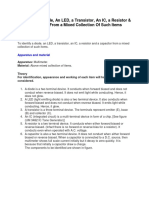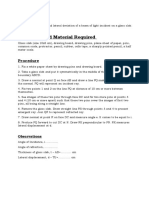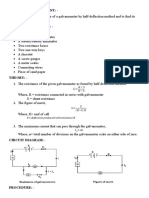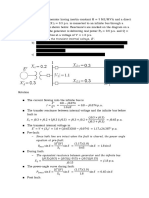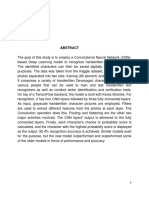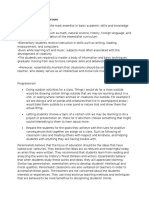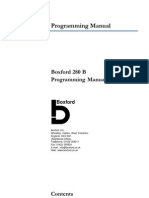100%(1)100% found this document useful (1 vote)
3K viewsTo Assemble A Household Circuit Comprising Three Bulbs, Three (On/off) Switches A Fuse and A Power Source.
To Assemble A Household Circuit Comprising Three Bulbs, Three (On/off) Switches A Fuse and A Power Source.
Uploaded by
Study MaterialThe document describes three activities related to assembling electrical circuits:
1. Assembling a household circuit with three bulbs, switches, a fuse and power source to understand series circuits and how switches control electricity flow.
2. Assembling circuit components including a resistor, ammeter, voltmeter, battery and key to demonstrate how the components function within a circuit.
3. Drawing a diagram of an open circuit including a battery, resistor, key, ammeter and voltmeter. The circuit is checked for proper connections and corrected if needed.
Copyright:
© All Rights Reserved
Available Formats
Download as PPTX, PDF, TXT or read online from Scribd
To Assemble A Household Circuit Comprising Three Bulbs, Three (On/off) Switches A Fuse and A Power Source.
To Assemble A Household Circuit Comprising Three Bulbs, Three (On/off) Switches A Fuse and A Power Source.
Uploaded by
Study Material100%(1)100% found this document useful (1 vote)
3K views4 pagesThe document describes three activities related to assembling electrical circuits:
1. Assembling a household circuit with three bulbs, switches, a fuse and power source to understand series circuits and how switches control electricity flow.
2. Assembling circuit components including a resistor, ammeter, voltmeter, battery and key to demonstrate how the components function within a circuit.
3. Drawing a diagram of an open circuit including a battery, resistor, key, ammeter and voltmeter. The circuit is checked for proper connections and corrected if needed.
Original Description:
Activity file
Original Title
To assemble a household circuit comprising three bulbs, three (on/off) switches a fuse and a power source.
Copyright
© © All Rights Reserved
Available Formats
PPTX, PDF, TXT or read online from Scribd
Share this document
Did you find this document useful?
Is this content inappropriate?
The document describes three activities related to assembling electrical circuits:
1. Assembling a household circuit with three bulbs, switches, a fuse and power source to understand series circuits and how switches control electricity flow.
2. Assembling circuit components including a resistor, ammeter, voltmeter, battery and key to demonstrate how the components function within a circuit.
3. Drawing a diagram of an open circuit including a battery, resistor, key, ammeter and voltmeter. The circuit is checked for proper connections and corrected if needed.
Copyright:
© All Rights Reserved
Available Formats
Download as PPTX, PDF, TXT or read online from Scribd
Download as pptx, pdf, or txt
100%(1)100% found this document useful (1 vote)
3K views4 pagesTo Assemble A Household Circuit Comprising Three Bulbs, Three (On/off) Switches A Fuse and A Power Source.
To Assemble A Household Circuit Comprising Three Bulbs, Three (On/off) Switches A Fuse and A Power Source.
Uploaded by
Study MaterialThe document describes three activities related to assembling electrical circuits:
1. Assembling a household circuit with three bulbs, switches, a fuse and power source to understand series circuits and how switches control electricity flow.
2. Assembling circuit components including a resistor, ammeter, voltmeter, battery and key to demonstrate how the components function within a circuit.
3. Drawing a diagram of an open circuit including a battery, resistor, key, ammeter and voltmeter. The circuit is checked for proper connections and corrected if needed.
Copyright:
© All Rights Reserved
Available Formats
Download as PPTX, PDF, TXT or read online from Scribd
Download as pptx, pdf, or txt
You are on page 1of 4
ACTIVITIES:1
Aim: To assemble a household circuit comprising three bulbs,
three (on/ off) switches a fuse and a power source.
Apparatus: Three blubs (6 V, 1 W) each, fuse of 0.6A,
main switch a power supply (battery eliminator), three (on/off)
switches flexible connecting wire with red and black plastic
covering, a fuse wire.
Theory: Electricity supplied to us for domestic purposes is
220 A.C. and 50 Hz. The household circuit, all appliances are
connected in 8parallel9 with mains. The switches are
connected in series with each appliances in live wire.5A
switches are required for heavy load appliances like refrigerator,
air conditioner, geyser, hot plates etc. All appliances must have
three wires called live, neutral and the earth. Total power
consumption 8P9 at a time
P = P1 + P2 +P3 +………………
Where P1, P2 , P3 are the powers drawn by appliances.
To protect the appliances from damage when unduly high
currents are drawn fuse of little higher rating, 10 to 20 higher
than the current normally drawn by all appliances. For further
safety, a suitable value MAINS FUSE like rating 32A is
connected in series and supply source.
• Procedure:
• 1. Connect the components as per the Wheatstone bridge circuit: battery, galvanometer, jockey, and a one-ohm standard resistor in series.
• 2. Attach the meter bridge wire in parallel with the galvanometer, and connect the unknown resistor in one gap and the known resistor in the
opposite gap.
• 3. Adjust the jockey along the meter bridge wire to find the null point (zero deflection) on the galvanometer.
• 4. Record the lengths L1 and L2 on either side of the null point.
• 5. Calculate the unknown resistance (R2) using the formula \( R1/R2 = L1/L2 \).
• 6. Repeat the experiment for series combination by connecting R2 in series with R1 and calculate the equivalent resistance (( R_eq = R1 +
R2 )).
• 7. Repeat for parallel combination by connecting R2 in parallel with R1 and calculate the equivalent resistance ( 1/R_eq = 1/R1 + 1/R2 )
• .8. Compare the experimental results with the theoretical predictions .
Conclusion: Creating this circuit helps understand the concept of a series circuit where the current flows through one
path. It also demonstrates the functionality of switches in controlling the flow of electricity to individual components
(bulbs, in this case).
The fuse acts as a safety measure, breaking the circuit if there's an excessive flow of current. Overall, it's a simple but
effective setup to grasp the basics of a household electrical circuit.
Precaution:
1.Ensure all wires are properly insulated and free from damage or wear.
2.Using electrical tape or wire nuts to cover exposed wires helps prevent accidental contact and potential hazards.
ACTIVITY :2
• AIM: To assemble the components of a given electrical circuit.
• MATERIAL REQUIRED: Resistor, ammeter, (0-1.5A) voltmeter (0-5V ), battery, one way key, rheostat,
sand paper, connecting wires.
• PROCEDURE:
• 1. Connect the components as shown in Figure.
• 2. After closing the key K, check that the voltmeter and ammeter show deflections on the right hand side.
• 3. Check the continuity of the assembled circuit using a multimeter .
• RESULT: The components of the electrical circuit were assembled
• PRECAUTIONS:
• 1. The positive terminal of the battery should be connected to the positive terminal of ammeter and positive terminal
of the voltmeter.
• 2. The ammeter should be connected in series with the resistor and the voltmeter should be connected in parallel with
the resistor.
• 3. Sand paper should be used to clean the ends of connecting wires and leads of the component terminals.
• Grease/oil or oxide on their surfaces is insulating in nature and needs to be removed. However, do not clean the plugs
and keys with sand paper. Excessive use of sand paper in such a case will make the plug unfit to be used with the key.
Activity :3
Aim :
To draw the diagram of a given open circuit comprising at least a battery, resistor/rheostat,
key, ammeter and voltmeter. Mark the components that are not connected in proper order
and correct the circuit and also the circuit diagram.
• Apparatus and material :
A battery eliminator or a battery (0 to 6 V), rheostat, resistance box (0 to 100 £2), two or one way key. D.C.
ammeter (0-3) A and a D.C. voltmeter (0-3) V.
• Theory:
An open circuit is the combination of primary components of electric circuit in a such a manner that on
closing the circuit no current is drawn from the battery.
Procedure
Ammeter: It should be connected in series, with the battery eliminator.
Voltmeter: It should be connected in parallel to the resistor.
Rheostat: It should be connected in series (in place of resistance coil) with the battery eliminator.
Resistance coil: It should be connected in parallel (in place of rheostat).
One way key: It should be connected in series to the battery eliminator.
You might also like
- Collected Male Dr. Svasti Report Status: Final: Name Lab No. P 159709569 Mr. Dushyant HoodaDocument2 pagesCollected Male Dr. Svasti Report Status: Final: Name Lab No. P 159709569 Mr. Dushyant Hoodadushyant33% (3)
- Expt.8 (To Find Focal Length of Concave Lens Using Convex Lens)Document4 pagesExpt.8 (To Find Focal Length of Concave Lens Using Convex Lens)ayushmanjee130378% (9)
- Activity de PhysicsDocument11 pagesActivity de Physicsshivam100% (3)
- SWOT Analysis For The MENA RegionDocument1 pageSWOT Analysis For The MENA RegionZekriNo ratings yet
- Activity Notes BookDocument12 pagesActivity Notes Bookkaran singh class 11 aNo ratings yet
- 2 To Draw The Diagram of A Given Open Circuit Comprising at Least A BatteryDocument2 pages2 To Draw The Diagram of A Given Open Circuit Comprising at Least A Batterymariamfernandes667% (6)
- Drawn Diagram of Given Open CKTDocument2 pagesDrawn Diagram of Given Open CKTRbcNo ratings yet
- Physics Activity FileDocument16 pagesPhysics Activity FileAyush Raj100% (1)
- Activity Activity Activity Activity Activity: ActivitiesDocument2 pagesActivity Activity Activity Activity Activity: ActivitiesHarsh ShahNo ratings yet
- To use a multimeter to (a) identify base of a multimeter (b) distinguish between non and pop type transistors (c) see the unidirectional flow of current in case of a diode and an LED (d) check whether a given electronic component (ex- diode, transistor, or IC) is in working orderDocument5 pagesTo use a multimeter to (a) identify base of a multimeter (b) distinguish between non and pop type transistors (c) see the unidirectional flow of current in case of a diode and an LED (d) check whether a given electronic component (ex- diode, transistor, or IC) is in working orderAurora Aurealis75% (4)
- To Study The Nature and Size of The Image Formed by A Convex Lens On A Screen by Using A Candle and A ScreenDocument2 pagesTo Study The Nature and Size of The Image Formed by A Convex Lens On A Screen by Using A Candle and A Screenarpit375rajputNo ratings yet
- Half Deflection ReadingsDocument5 pagesHalf Deflection ReadingsAritra RoyNo ratings yet
- To Study Effect of Intensity of Light (By Varying Distance of He Source) On An LDRDocument3 pagesTo Study Effect of Intensity of Light (By Varying Distance of He Source) On An LDRAlura33% (3)
- Experiment 8Document5 pagesExperiment 8Gurdeep Singh Saggu100% (2)
- To Identify A Diode, An LED, A Transistor, An IC, A Resistor & A Capacitor From A Mixed Collection of Such ItemsDocument3 pagesTo Identify A Diode, An LED, A Transistor, An IC, A Resistor & A Capacitor From A Mixed Collection of Such ItemsHarsh Patidar50% (2)
- Meter Bridge-Specific ResistanceDocument3 pagesMeter Bridge-Specific ResistancekirtiNo ratings yet
- To Determine Resistance of A Galvanometer by Half-Deflection Method and To Find Its Figure of MeritDocument3 pagesTo Determine Resistance of A Galvanometer by Half-Deflection Method and To Find Its Figure of Meritatikshpro3004100% (3)
- Activity 3Document3 pagesActivity 3KU67% (3)
- To Verify The Laws of Combination (Series) of Resistances Using A Metre BridgeDocument3 pagesTo Verify The Laws of Combination (Series) of Resistances Using A Metre Bridgeatikshpro3004No ratings yet
- Experiment 2 PhysicsDocument5 pagesExperiment 2 Physicsansh BeniwalNo ratings yet
- Experiment 3 - Meterbridge ParallelDocument7 pagesExperiment 3 - Meterbridge Parallelayushmanjee1303100% (1)
- Refractive Index of A Liquid by Using Convex LensDocument3 pagesRefractive Index of A Liquid by Using Convex LensHEADLINES DAILY100% (1)
- To Identify Led, Diode, TransistorDocument4 pagesTo Identify Led, Diode, TransistorABHISHEK TIWARI79% (14)
- Half Deflection of GalvanometerDocument3 pagesHalf Deflection of GalvanometerTamanna NayakNo ratings yet
- Frequency of Ac MainsDocument2 pagesFrequency of Ac Mainsharsh50% (4)
- Variation of Cell Potential in ZnZn2 Cu2+Cu With Change in Concentration of Electrolytes (CuSO4 or ZnSO4) at Room TemperatureDocument5 pagesVariation of Cell Potential in ZnZn2 Cu2+Cu With Change in Concentration of Electrolytes (CuSO4 or ZnSO4) at Room TemperatureauroraborealisacNo ratings yet
- Physics Practicals - XII (24-25)Document2 pagesPhysics Practicals - XII (24-25)Shubhra khatri50% (2)
- To Determine Resistance Per CM of A Given Wire by Plotting A Graph of Potential Difference Versus Current and Reading of PraticalDocument14 pagesTo Determine Resistance Per CM of A Given Wire by Plotting A Graph of Potential Difference Versus Current and Reading of PraticalSATYAM X-C100% (5)
- To Separate The Pigments Extract From Spinach Leaves by Paper Chromatography and Determine Their RF ValuesDocument2 pagesTo Separate The Pigments Extract From Spinach Leaves by Paper Chromatography and Determine Their RF ValuesBipul KumarNo ratings yet
- To Verify The Laws of The Parallel Combination of ResistancesDocument3 pagesTo Verify The Laws of The Parallel Combination of Resistancesanamika7005865200No ratings yet
- AC SonometerDocument2 pagesAC Sonometerkirti100% (1)
- To Assemble The Components of A Given Electrical CircuitDocument2 pagesTo Assemble The Components of A Given Electrical Circuitarpit375rajput100% (4)
- To Determine Angle of Minimum Deviation For A Given Prism by Plotting A Graph Between Angle of Incidence and Angle of Deviation PDFDocument6 pagesTo Determine Angle of Minimum Deviation For A Given Prism by Plotting A Graph Between Angle of Incidence and Angle of Deviation PDFriyanmedhi04No ratings yet
- Focal Length of Convex Lens by Plotting The Graph Between U and VDocument7 pagesFocal Length of Convex Lens by Plotting The Graph Between U and VSwapnil Khora100% (1)
- Focal Length of A Convex Mirror Using Convex Lens 1Document2 pagesFocal Length of A Convex Mirror Using Convex Lens 1mahatimahidevkar80% (5)
- Physics Activity-4Document3 pagesPhysics Activity-4ABHISHEK TIWARI100% (1)
- Focal Lenght of Convex Mirror Using Convex LensDocument2 pagesFocal Lenght of Convex Mirror Using Convex LensAmit Sutar100% (4)
- Activity JD 2Document5 pagesActivity JD 2Janardan Dubey100% (5)
- To Study The Variation in Potential Drop With Length of A Wire For Steady CurrentDocument3 pagesTo Study The Variation in Potential Drop With Length of A Wire For Steady Currentaff bear40% (5)
- Focal Length of Convex Lens by Plotting GraphsDocument2 pagesFocal Length of Convex Lens by Plotting Graphsh100% (4)
- Travelling MicroscopeDocument3 pagesTravelling MicroscopeRohan Mohanty100% (1)
- To Measure Resistance, Voltage (AC/DC), Current (AC) and Check Continuity of A Given Circuit Using MultimeterDocument2 pagesTo Measure Resistance, Voltage (AC/DC), Current (AC) and Check Continuity of A Given Circuit Using Multimeteraman71% (21)
- Physics Activity 2Document4 pagesPhysics Activity 2Ankit PanigrahiNo ratings yet
- To Find Refractive Index of A Liquid Using Concave MirrorDocument3 pagesTo Find Refractive Index of A Liquid Using Concave MirrorDraco Ayush100% (3)
- Physics Practical 22-23Document25 pagesPhysics Practical 22-23Arnav100% (1)
- Refractive Index of Liquid Using Convex Lens and Plane MirrorDocument4 pagesRefractive Index of Liquid Using Convex Lens and Plane Mirroralekse90% (10)
- P-N Junction Practical Class 12Document3 pagesP-N Junction Practical Class 12Swapnil Sahu75% (8)
- Travelling MicroscopeDocument2 pagesTravelling MicroscopeSiddhant Singh80% (5)
- 7.concave MirrorDocument3 pages7.concave Mirrorkirti100% (1)
- Physics-Investigatory To Find The Refractive Indices of (A) Water (B) Oil (Transparent) Using A Plane Mirror, An Equiconvex LensDocument17 pagesPhysics-Investigatory To Find The Refractive Indices of (A) Water (B) Oil (Transparent) Using A Plane Mirror, An Equiconvex Lensnagendra.bncNo ratings yet
- Figure of Merit Expt.4Document4 pagesFigure of Merit Expt.4Priyanshu Kumar90% (10)
- Focal Length of Convex LensDocument5 pagesFocal Length of Convex LensHey AnuragNo ratings yet
- NOTES (2023-2024) Subject: Physics Lab Manual Class: Xii Sec: A Experiment No:4 - Convex LensDocument4 pagesNOTES (2023-2024) Subject: Physics Lab Manual Class: Xii Sec: A Experiment No:4 - Convex LensMichael Ibrahim0% (1)
- Activities - Section ADocument11 pagesActivities - Section AKrishnashis DasNo ratings yet
- Six Activities Class 12Document16 pagesSix Activities Class 12Priyanshu jhaNo ratings yet
- List of ActivitiesDocument15 pagesList of Activitieskaustubhkushagra9No ratings yet
- 2dz50nZRWnDocument18 pages2dz50nZRWnAdamya AroraNo ratings yet
- Physics 1Document17 pagesPhysics 1ashishktomar33No ratings yet
- Deek ShaDocument13 pagesDeek ShaShivani SharmaNo ratings yet
- Boat Maintenance Companions: Electrics & Diesel Companions at SeaFrom EverandBoat Maintenance Companions: Electrics & Diesel Companions at SeaNo ratings yet
- Design of Electrical Circuits using Engineering Software ToolsFrom EverandDesign of Electrical Circuits using Engineering Software ToolsNo ratings yet
- Since Both Line Are Intact When The Fault Is Cleared, The Power Angle Equation at Pre-FaultDocument2 pagesSince Both Line Are Intact When The Fault Is Cleared, The Power Angle Equation at Pre-Faultsebinjosephsabi8914No ratings yet
- TopicsDocument10 pagesTopicsKiven M. GeonzonNo ratings yet
- Contextualize WorksheetDocument5 pagesContextualize WorksheetCaryl OrpianoNo ratings yet
- Nonlinear RegressionDocument21 pagesNonlinear RegressionTesfayeNo ratings yet
- Mquay ChilledDocument84 pagesMquay ChilledRidwan Pramudya100% (1)
- Number System - DPP 02 English - (Brahmastra SSC Foundation)Document3 pagesNumber System - DPP 02 English - (Brahmastra SSC Foundation)kprakash8599No ratings yet
- Digital Logic Design: Discreet Realization of Logic GatesDocument17 pagesDigital Logic Design: Discreet Realization of Logic GatesAnonymous AFFiZnNo ratings yet
- Architecture of (Vxworks) : Labview ProgramsDocument14 pagesArchitecture of (Vxworks) : Labview ProgramsRangaRaj100% (2)
- Rafik Isaa BeekunDocument5 pagesRafik Isaa BeekunanggitaNo ratings yet
- Who Is at RiskDocument1 pageWho Is at Riskelorenzana0511No ratings yet
- General Electric's Proposed Acquisition of HoneywellDocument19 pagesGeneral Electric's Proposed Acquisition of HoneywellMichael Martin Sommer100% (2)
- 1988 - Sachdeva - Two-Phase Flow Through Electric Submersible PumpsDocument279 pages1988 - Sachdeva - Two-Phase Flow Through Electric Submersible PumpsCesar AlataNo ratings yet
- Dr. Ivan Panin, The Bible Codes and Patterns of SevensDocument6 pagesDr. Ivan Panin, The Bible Codes and Patterns of SevensTeri Wayne BallardNo ratings yet
- Sat - 23.Pdf - Handwritten Hindi Character Recognition Using CNNDocument11 pagesSat - 23.Pdf - Handwritten Hindi Character Recognition Using CNNVj KumarNo ratings yet
- Suggested Things To Do On First Day of SchoolDocument3 pagesSuggested Things To Do On First Day of SchoolJOHN RULF OMAYANNo ratings yet
- PLC and NFC ApplicationDocument8 pagesPLC and NFC Applicationahmad zailaniNo ratings yet
- Pan X Parts LocatorDocument25 pagesPan X Parts Locatoralpharepair100% (1)
- Fitbit Versa 3 User ManualDocument92 pagesFitbit Versa 3 User Manualp-j-wNo ratings yet
- 2018fa CS61C L10 BN FormatsDocument29 pages2018fa CS61C L10 BN FormatsHeks JohnNo ratings yet
- Atm and Role of Atm in BankingDocument9 pagesAtm and Role of Atm in BankingDrAbhishek SarafNo ratings yet
- Bill of Materials and Cost Estimate: EarthworksDocument3 pagesBill of Materials and Cost Estimate: Earthworksjansenroses100% (2)
- HO5 Business Combination at Acquisition DateDocument4 pagesHO5 Business Combination at Acquisition Dateitzadizazta01No ratings yet
- The Essentialist ClassroomDocument2 pagesThe Essentialist ClassroomDennis Raymundo50% (2)
- Manual de CNC TornoDocument147 pagesManual de CNC TornoAbraham Pool100% (1)
- Medical Biotechnology BrochureDocument12 pagesMedical Biotechnology BrochuretanasedanielaNo ratings yet
- Synfocity : 1 Kohhran Hmeichhe Inkhawmpui Lian 2017 A Tiak TaDocument2 pagesSynfocity : 1 Kohhran Hmeichhe Inkhawmpui Lian 2017 A Tiak TaMizoram Presbyterian Church SynodNo ratings yet
- Acid Base and Salts - Index-Notes FinalDocument5 pagesAcid Base and Salts - Index-Notes FinalYatish BalamuruganNo ratings yet
- Royer - A Switching Transistor D-C To A-CDocument5 pagesRoyer - A Switching Transistor D-C To A-CAnonymous keAMIVNo ratings yet














